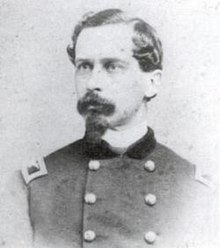The Irish Brigade was an infantry brigade, consisting predominantly of Irish Americans, who served in the Union Army in the American Civil War. The designation of the first regiment in the brigade, the 69th New York Infantry, or the "Fighting 69th," continued in later wars. The Irish Brigade was known in part for its famous war cry, the "Faugh a Ballaugh" which is an anglicization of the Irish phrase, fág an bealach, meaning "clear the way" and used in various Irish-majority military units founded due to the Irish diaspora. According to Fox's Regimental Losses, of all Union army brigades, only the 1st Vermont Brigade and Iron Brigade suffered more combat dead than the Irish Brigade during America's Civil War.

The Pennsylvania Reserves were an infantry division in the Union Army during the American Civil War. Noted for its famous commanders and high casualties, it served in the Eastern Theater, and fought in many important battles, including Antietam and Gettysburg.
The 14th Indiana Infantry Regiment, called "The Gallant Fourteenth," was an infantry regiment and part of the Union Army's celebrated "Gibraltar Brigade" during the American Civil War. Mustered on June 7, 1861, it was the state's first regiment organized for three years' service. The 14th Indiana served in many major campaigns and battles mostly in the Eastern Theater. During its three years of service, the regiment had a total of 222 casualties.
Cobb's Legion was an American Civil War Confederate States Army unit that was raised from the state of Georgia by Thomas Reade Rootes Cobb during the summer of 1861. A legion in the Civil War usually meant a combined-arms unit, consisting of two or three branches of the military: infantry, cavalry, and artillery. When it was originally raised, the Georgia Legion comprised 600 infantrymen in the infantry battalions, 300 cavalry troopers in the cavalry battalions, and 100 artillerists in a single battery. The legion concept was not practical for Civil War armies and, soon after Robert E. Lee took command of the Army of Northern Virginia on June 1, 1862, the individual elements were assigned to other units.
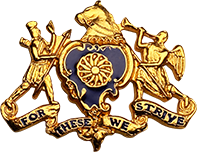
The First Troop Philadelphia City Cavalry, also known as the First City Troop, is a unit of the Pennsylvania Army National Guard. It is one of the oldest military units in the United States still in active service and is among the most decorated units in the U.S. Army. Accordingly, the Troop operates under a number of principles of self-governance unique in the U.S. military, including the election of unit members and officers, voluntarily forgoing pay for military service to the country, continuing to practice horse cavalry skills and tactics, and recruiting a high percentage of its members from veterans of prior active duty service across all branches, as well as older civilian mid-career professionals.
Henry J. Stainrook, occasionally spelled Steinrock, led a regiment of the Army of Virginia and the Army of the Potomac in the American Civil War. He briefly led a brigade at the Battle of Antietam. Stainrook was killed in the Battle of Chancellorsville.

James Nagle was an officer in the United States Army in both the Mexican–American War and the American Civil War. During the latter conflict, he recruited and commanded four infantry regiments from the commonwealth of Pennsylvania and led two different brigades in the Eastern Theater. As the war progressed, worsening health problems precluded prolonged field service, but Nagle is perhaps best known for his actions at the 1862 Battle of Antietam, where his brigade played a key role in securing Burnside's Bridge, a key crossing over the contested Antietam Creek.

The 5th Ohio Infantry Regiment was an infantry regiment from southwestern Ohio that served in the Union Army during the American Civil War, serving in both the Eastern and Western Theaters in a series of campaigns and battles. It was noted for its holding the high ground at the center of the line at Antietam as part of Tyndale's 1st Brigade, Greene's 2nd Division of Mansfield's XII Corps.
The 6th Pennsylvania Cavalry was a Union Army cavalry regiment that served in the Army of the Potomac and the Army of the Shenandoah during the American Civil War. It was formed in 1861 as the Philadelphia Light Cavalry and the 70th Regiment of the Pennsylvania Volunteers by Richard H. Rush who also served as colonel from 1861 to 1862. At the request of Major General George B. McClellan, the regiment was equipped with lances which prompted the unit to be known as "Rush's Lancers." The lances proved ineffective in battle and the regiment was issued carbine rifles in 1863. The regiment served in many of the key battles in the Eastern theater of the American Civil War and were mustered out in August 1865.
The Thirteenth Pennsylvania Reserve Regiment, also known as the 42nd Pennsylvania Volunteer Infantry, the 1st Pennsylvania Rifles, Kane's Rifles, or simply the "Bucktails," was a volunteer infantry regiment that served in the Union Army during the American Civil War. It was a part of the famed Pennsylvania Reserve division in the Army of the Potomac for much of the early and middle parts of the war, and served in the Eastern Theater in a number of important battles, including Antietam, Fredericksburg, and Gettysburg.

Samuel Henry Starr was a career United States Army officer, regimental commander and prisoner of war. A collection of his letters provide a rare view of military life, the War with Mexico, Indian conflicts, the Civil War, his fall from grace, recovery and post Civil War service. Despite his rough demeanor he was a religious man and reflective of the times he served.

Hector Tyndale was an American military officer who served in the Union army during the American Civil War. He fought at the Second Battle of Bull Run and the Battle of Antietam. He was wounded twice during the Battle of Antietam and thought dead from a head wound. After his recovery, he returned to active duty and fought in the Battle of Wauhatchie and the Battle of Missionary Ridge. He was brevetted to Brigadier General for his actions at Antietam and to Major General at the end of the war for gallantry and meritorious service. He was a successful businessman who owned and operated a glass and china importation firm in Philadelphia.
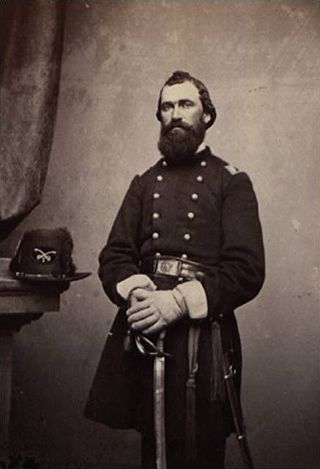
Jacob C. Higgins (1826–1893) was a commander of Pennsylvania troops who participated in both major military conflicts of his time, the Mexican–American War and the American Civil War. Among his Civil War commands, he guided the 125th Pennsylvania Infantry regiment under heavy fire during the Battle of Antietam and likewise during the Battle of Chancellorsville. Following the muster out and return home of the 125th PA, the Gettysburg Campaign sent cavalry under Confederate General John D. Imboden to threaten vital railroad resources at Altoona and iron production facilities in the Juniata River watershed; in response, Emergency Militia was organized by Colonel Higgins and minimized this northwestern incursion.
The following list is a Bibliography of American Civil War Union military unit histories. More details on each book are available at WorldCat.
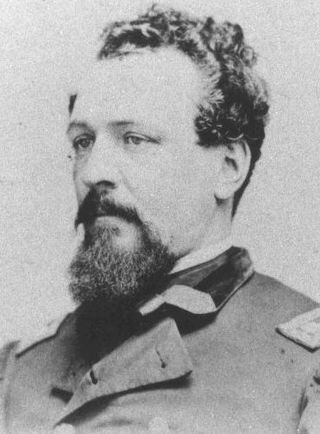
James Gwyn was an officer in the Union Army during the American Civil War. He immigrated at a young age from Ireland in 1846, initially working as a storekeeper in Philadelphia and later as a clerk in New York City. At the onset of the war, in 1861, he enlisted and was commissioned as a captain with the 23rd Pennsylvania Volunteer Infantry. He assumed command of the 118th Pennsylvania Regiment in the course of the war. Gwyn led that regiment through many of its 39 recorded battles, including engagements at Seven Pines, Fredericksburg, Shepherdstown, Five Forks, Gettysburg, and Appomattox Court House.
The 1st Pennsylvania Cavalry was a cavalry regiment that served in the Union Army as part of the Pennsylvania Reserves infantry division during the American Civil War.

The 28th Pennsylvania Volunteer Infantry was an infantry regiment that served in the Union Army during the American Civil War. It was noted for its holding the high ground at the center of the line at Antietam as part of Tyndale's 1st Brigade, Greene's 2nd Division of Mansfield's XII Corps.
The 12th Pennsylvania Cavalry was a cavalry regiment that served in the Union Army during the American Civil War.
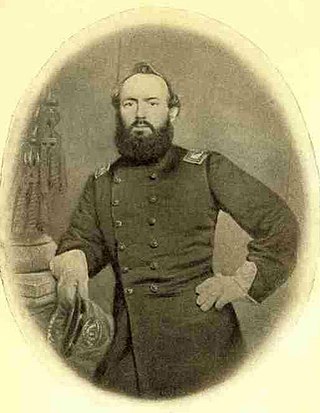
Albert Lewis Magilton was an American colonel who served the Union during the American Civil War who commanded the 4th Pennsylvania Reserve Regiment and who participated the Battle of Antietam under the command of George Meade.
